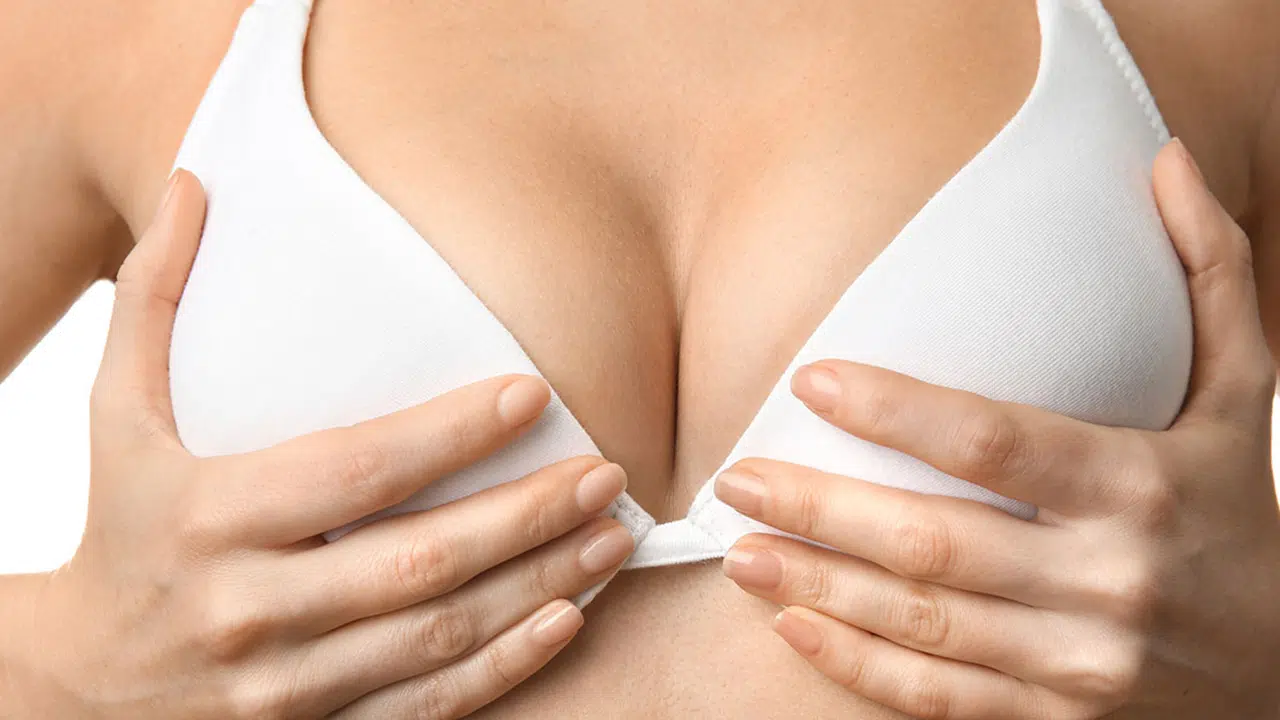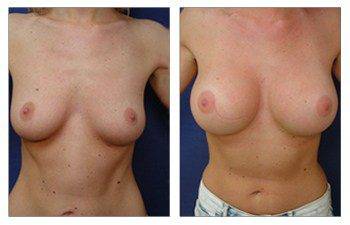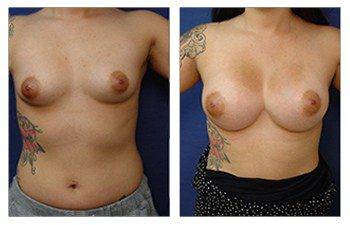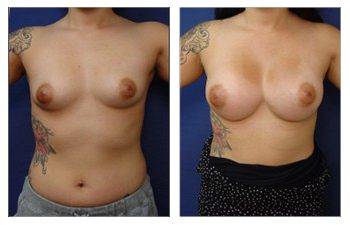Breast Augmentation
Breast Augmentation Newport Beach - IMPLANTS CASE STUDIES
Breast Augmentation
Newport Beach
Breast augmentation Newport Beach style by SurgiSculpt.
Our Breast Augmentation procedure uses Natrelle™ and focuses on enhancing breast shape and volume for patients who have identified one of the concerns below:
- I wish to have larger breasts.
- I wish that my breasts were symmetrical.
- Noticed tightening, firmness, and distortion of their breasts. (Please see Breast Augmentation Revision)
- Women with breast implants notice deflation of their implants following breast augmentation. (Please see Breast Augmentation Revision)
- Observed slight drooping of their breasts due to the natural aging process. (Please see Breast Lift with Implant Augmentation)
- The observed loss of volume and drooping of their breasts following pregnancy and breastfeeding and/or weight loss. (Please see Breast Lift with Implant Augmentation)
One of the most important decisions you can make when considering breast augmentation is the selection of an experienced, board-certified plastic surgeon. SurgiSculpti, located in Newport Beach, Orange County, is considered an expert in breast augmentation surgery and has developed Breast Augmentation with Natrelle™ to ensure that you attain your maximum potential following breast augmentation surgery. Breast Augmentation Natrelle™ optimizes all aspects of the breast augmentation experience, including your initial confidential consultation, an anxiety-free operation, comfortable postoperative recovery, a speedy return to full activity, and long-lasting results.
During your initial breast augmentation Newport Beach consultation with SurgiSculpt, you will have the opportunity to convey to him precisely what concerns you regarding your breasts. SurgiSculpt will complete a thorough history and physical, which is the first step toward ensuring optimum results. During this consultation, SurgiSculpt will examine your breasts and take detailed notes and measurements to ensure that the appropriate surgical plan to correct/improve your breast aesthetics.
The Orange County Cosmetic and Plastic Surgeons at SurgiSculpt will perform a breast augmentation Newport Beach Style examination. The exam will take into account:
- Your breast mound size and any asymmetry;
- Your nipple-areola complex positioning and any asymmetry;
- Your medial cleavage fullness or lack of;
- Your lateral breast mound concavity;
- Your inframammary crease positioning and any asymmetry;
- Your breast mound diameter and chest muscle and wall width;
- Your nipple-areola complex to inframammary crease distance and any asymmetry;
- Your breast skin and soft tissue thickness
- Your pectoralis muscle tone and asymmetry
Virtual Sizing for Breast Implants
You will then enjoy trying on a full array of types of breast implant sizes so that you can actually see and feel the look that you desire. Although you will have your patient coordinator helping you go through the various implant type, size and shape options, SurgiSculpt encourages you to bring your significant other, family, and/or friend to help you choose the implant size that will achieve the look you are striving for. Finally, SurgiSculpt encourages you to bring your own undergarments (bras with no padding) and tops (tight shirts preferred) so that you can appreciate how the various types of implant sizes and shapes will affect your silhouette in your own clothes. Please take your time to view our extensive Newport Beach Breast Augmentation before and after gallery.
Preoperative planning for a Breast Augmentation surgical procedure at Newport Beach, Orange County, includes:
- Arranging for time off of work during your recovery period.
- Preparing meals and routine daily needs ahead of time.
- Wash with antimicrobial soap starting 4 days before surgery.
- Providing anti-anxiety medications on the night before and on the day of surgery.
- Planning for a responsible adult to accompany you to and from surgery and for the first 72 hours following surgery.
Breast Augmentation Natrelle™ implant type focuses on several operative measures taken by SurgiSculpt to optimize your results.
- Use only FDA-approved breast implants made by Mentor and/or Allergan Corporation to ensure the longevity of your implants.
- Provide perioperative antibiotics through your IV to minimize the risk of infection.
- Utilize extended surgical drapes to ensure sterility throughout your case.
- Utilize nipple-areola shields to avoid bacterial contamination of your implants from endogenous bacteria that typically live within the breast glands.
- Use a bi-planar surgical technique to correct slight nipple-areola and/or breast mound asymmetry.
- Use anatomic landmarks for pectoral muscle release to ensure the symmetric release of muscles and subsequent symmetry of the proposed breast implant's pocket plane position.
- Use non-powdered gloves and subsequently irrigate gloves with antibiotics solution to avoid all irritants that could cause capsular contracture.
- Use antibiotic solution to irrigate the surgical breast pocket and breast implants in addition to the surgeon's gloves to minimize the risk of infection.
- Use of minimal touch technique when handling breast implants before implantation.
- Use sterile breast implant sizes before committing to your final breast implant.
- Maintaining an array of breast implant sizes and shapes on consignment at our surgery center so that size adjustments can be considered during your operation should unexpected intraoperative findings be made.
- Placement of specialized breast garment, i.e., breast band, maximizes maintenance of breast implant position and avoids implant malposition.
Breast augmentation Newport Beach is very common, and all-inclusive costs start at $5000 when performed by expert board-certified plastic surgeons. This all-inclusive fee includes the surgeon's fee, operating room fee, anesthesia fees, implant fees, breast band/garment, and all of your postoperative visits. SurgiSculpt will ensure that your results meet your expectations.
We dedicated this practice to ensuring you achieve the breast shape you desire. Breast Augmentation Newport Beach - Natrelle TM is dedicated to restoring and/or augmenting breasts to their natural contour and youthful appearance.
Natrelle™ is a trademark of Allergan Corporation.
Breast Augmentation Newport Beach - Procedure
Enlargement of the female breasts using breast implants made of saline and/or silicone to enhance the breast-to-body size proportions.
Breast Augmentation Length
1 to 2 hours of operating room time.
Breast Augmentation Anesthesia
General anesthesia (the implant is placed under the muscle) or conscious sedation (the implant is placed over the muscle).
Breast Augmentation Place of Treatment
Outpatient surgical suite or hospital operating room.
Breast Augmentation Risks
1) Deep vein thrombosis (DVT) may occur in the legs immediately following surgery. DVT refers to the clotting off of leg veins which may result in compromised blood flow return from the legs; a more critical consequence may develop from this clot if it is dislodged and travels to the lungs causing pulmonary emboli. Although rare, pulmonary emboli are the leading cause of death following surgery.
2) Wound breakdown is more common in these patients, secondary to several metabolic and physiologic disorders. Diabetes and nutritional deficiencies are primarily to blame for the problematic healing of these patients.
3) Seroma formation refers to the accumulation of plasma fluid in pockets created by the surgical elevation of the soft tissue. This fluid accumulates due to a low blood count and protein deficiency, which is often present in Breast Augmentation patients. This fluid can be a nuisance to patients requiring several aspirations in the office before their resolution. More importantly, these plasma fluid pockets may harbor bacterial growth and result in a clinical infection.
4) Local skin infection is not uncommon in a patient who has diabetes, iron deficiency anemia (low blood count), shortness of breath, and protein deficiency.
5) Pressure sores may develop in patients following prolonged surgical cases due to the increased weight of the patients on an operating room table. Fortunately, pressure sores rarely develop due to the precautions taken by the operating room staff to cushion all bony prominences properly.
6) Breast Augmentation patients are more susceptible to hypothermia (loss of body temperature) due to their larger body surface area to body volume ratio. Hypothermia may lead to arrhythmias and blood clotting difficulties in the operating room. Fortunately, patients' body temperatures rarely fall due to the precautions taken in the operating room, which include: heating the room, heating of the intravenous fluids, and using special heating blankets.
Breast Augmentation Recovery
The recovery period for breast augmentation in Newport Beach with a return to daily activities is usually one week. Patients are asked to forego physical activities, heavy lifting, and exercise for approximately four weeks after surgery.
Breast Augmentation Duration of Results
Patients undergoing breast augmentation Newport Beach surgery can expect aesthetically pleasing results for several decades. Early revisions are due to implant deflation (1 % per year). Late revisions are needed if the breast becomes distorted (due to the thickening of the capsule surrounding the implant) or sagging of the breast from the normal aging process and increased weight of the implants.
Breast Augmentation Newport Beach - FREQUENTLY ASKED QUESTIONS
What is the history of breast augmentation surgery?
The first reported breast augmentation was performed by Czerny in 1895 using fat transfer from the patient's fat. He used fat that he had removed from a fatty tumor called a lipoma. In the early part of the century, synthetic injections were attempted by Germany in 1899 (paraffin) and by Pangman in 1951 (synthetic polyvinyl alcohol and formaldehyde polymer). In 1963, two United States physicians named Cronin and Gerow introduced the popular silicone gel-filled implants used today.
Are silicone implants allowed in the United States?
n 1991, a moratorium was placed by the F.D.A. for the use of silicone implants. This decision was based on a concern from numerous women across the country who felt that their implants were responsible for developing immune disorders and breast cancers. Although the move to halt all silicone implants was controversial, the physicians agreed that further clinical trials should be performed to determine the safety of silicone implants. Over a decade of studies have shown that silicone implants have no relation to the development of immune disorders and that women who have silicone implants are less likely to develop breast cancer. In March of 2007, the F.D.A. re-approved silicone implants in all women aged 22 or older.
If I have breast implants, can I receive silicone implants?
Before March 2007, silicone implants could only be placed in women who needed replacement of their implants due to breast implant silent rupture (saline or silicone), in women who had sagging of the breast requiring a breast lift, in women who had chest wall deformities, in women who had breast asymmetry or tuberous breast deformities, and in women who needed breast reconstruction for breast cancer. Only saline breast implants are allowed for all other patients considering breast augmentation for the first time. As of March 2007, the F.D.A. approved silicone implants in all women aged 22 years and older.
Am I a good candidate for breast augmentation surgery?
Most women who desire enlargement of their breasts are good candidates for breast augmentation surgery. In general, it is safer to place implants in patients who have not previously had breast symptoms such as breast tenderness, breast lumps, nipple areola discharge, and breast infection. In addition, if the patient has a family history of breast cancer, this can be concerning because it may increase the likelihood of breast cancer in the patient. If you have experienced any of the above concerns, a mammogram is recommended to detect any breast abnormality before breast augmentation surgery.
Indications for breast augmentation include inadequate breast volume and developmental delays in breast growth or breast cancer surgery. Additionally, breast augmentation has proven to benefit psychological conditions such as low self-esteem, lack of self-confidence, or sexual inhibition. Finally, small degrees of breast droop (up to 2 cm) can be corrected with a breast implant placement. Patients who wish to correct a higher degree of breast droop may consider a breast lift alone or in conjunction with implant augmentation.
What does breast augmentation surgery involve?
The breast implant surgery involves placement of accurate preoperative markings, including the midline of the chest, the incision line (determined by the approach used), the inframammary crease (fold under the breast), and the pocket that is going to be dissected to fit the implant. The pocket size is determined by the implant size selected.
Following placement of the implants, the patient is sat upright so that breast symmetry can be confirmed. If there are asymmetries, the patient is placed back down, and either pocket dissection or implant volumes are adjusted until symmetry is achieved.
Finally, the incision is closed in multiple layers and using plastic surgery closure techniques to ensure the protection of the implant and an aesthetically pleasing incision line.
The various approaches to breast augmentation include:
Inframammary crease(in the breast fold): this approach provides the surgeon the best visualization of the breast pocket he/she is dissecting, thus ensuring breast symmetry following breast augmentation surgery. The most important advantage of this approach is that it provides the most direct access to the surgical pocket if additional surgery is required.
- Periareolar (around the areola): when this incision heals well, it can be very well camouflaged. However, this incision is associated with several disadvantages, including surgical trauma to the breast glands, increased potential for nipple numbness, and poor scarring when revision surgery is required. Since the incision is circular, if opened a second time, it tends to contract into a straight line when healed, thus distorting the areola.
- transaxillary (in the armpit): This incision tends to hide well as long as you don't have to raise your arms as part of your occupation. However, it has several disadvantages, including more difficult dissection resulting in more difficulty obtaining symmetrical pockets, the potential for arm numbness, the potential for damaging large veins to the arm, which, if damaged, could result in prolonged arm swelling, and a necessity to convert to another incision if a revision is necessary (revisions may include correcting asymmetry or to remove a thickened capsule scar). Breast implants using the armpit technique are usually placed under the pectoralis muscle.
How do I plan for breast augmentation surgery?
On your initial visit, your surgeon will evaluate your health status by obtaining blood work. If you are 40 years or older or have had a history of breast symptoms (tenderness, lumps, nipple discharge), you will have to obtain a mammogram. If you are a smoker, you should quit for one month before breast augmentation surgery to minimize the risks of implant infection. In addition, it is prudent to quit smoking for six weeks following surgery to ensure a well-healed surgical incision line. Finally, you will need to arrange for a friend or a spouse to care for any small children who may need to be lifted since you will be sore for the first couple of days following surgery.
How do I prepare for breast augmentation surgery?
Since your surgery will require general anesthesia and/or intravenous sedation, you must take several precautions before surgery. First, you must avoid eating and drinking after midnight on the day before surgery. This precaution ensures that your stomach is clear of digested foods that could potentially be aspirated into your lungs during induction of anesthesia. Since you will have anesthetic medications administered throughout the case, you will remain groggy for several hours and require a ride to and from the surgery center. You should choose a conscientious caretaker who can spend the first night with you.
What results can I expect after breast augmentation surgery?
Patients who undergo breast augmentation surgery are extremely satisfied with their surgery and will notice an immediate improvement in their breast-to-body silhouette. A thorough preoperative assessment, safe intraoperative course, and close monitoring with frequent postoperative visits ensure that patients experience a speedy recovery and a return to a more productive and rewarding life. Patients are extremely pleased with breast augmentation surgery and radiate increased physical and mental confidence.
Where will my breast augmentation surgery be performed?
Since breast augmentation surgery will require general anesthesia, it must be performed in an operating room that is part of a hospital institution or outpatient surgery center. Less frequently, patients may be operated on in an in-house office-based operating room. Still, it is of utmost importance for patients to ensure that the office facility is accredited by a surgical accreditation body such as AAAASF.
What type of anesthesia will be used for my breast augmentation surgery?
For routine breast augmentation, the implants are placed in a submuscular plane which will require general anesthesia. For specific individuals, a sub-glandular (over the muscle) plane is recommended, for which conscious sedation (sedation through intravenous medications only) will suffice.
What should I expect after breast augmentation surgery?
Patients will awaken from general anesthesia to find their breasts wrapped with Ace Wraps as well as a breast band. The Ace wraps are to support the implants in their newly created pocket. The breast band is to prevent the implants moving up on the chest wall. Although this is not intuitive, for the first three weeks following surgery, breast implants tend to want to move up on the chest wall against gravity. The band counters this movement and ensures that the breast implant stay in the desired position. Patients will feel sore throughout the first 2 to 3 postoperative days. By placing long lasting local anesthetic solution in the breast pockets prior to closing the incisions, this soreness is minimized . Patients are asked to avoid lifting of weights greater than 15 pounds for the first two weeks. Incision lines will be sealed with special tape (steri-strips) for the first 36 hours so showering is delayed until the 2nd day following surgery. Finally, exercise should be limited for the first 4 weeks until the incisions and the breast pocket have completely healed.
When will I be able to return to work following breast augmentation surgery?
Patients will awaken from general anesthesia to find their breasts wrapped with Ace Wraps, surgical tape, and a breast band. The Ace wraps are to support the implants in their newly created pocket. The breast band prevents the implants from moving up on the chest wall. Although this is not intuitive, for the first three weeks following surgery, breast implants tend to want to move up on the chest wall against gravity. The band counters this movement and ensures that the breast implant stays in the desired position. Patients will feel sore throughout the first 2 to 3 postoperative days. This soreness is minimized by placing the long-lasting local anesthetic solution in the breast pockets before closing the incisions. Patients are asked to avoid lifting weights greater than 15 pounds for the first two weeks. Incision lines will be sealed with special tape (steri-strips) for the first 36 hours, so showering is delayed until the 2nd day following surgery. Finally, exercise should be limited for the first four weeks until the incisions and the breast pockets have completely healed.
Patients can expect to return to work at the earliest, 4 to 5 days following surgery if they have a sitting job. Generally, patients are recommended to take 1one week off if their work permits. Weight restrictions are set at 15 pounds for the first two weeks to guide patients who may have more physical jobs.
Are there any side effects associated with breast augmentation surgery?
Several side effects and breast implant complications have been associated with breast augmentation surgery, and these include:
- High-riding implants: Patient's frequently noticed high-riding implants in the early postoperative period. The implants will drop into their desired, aesthetically pleasing position within 2 to 4 weeks. The tendency for the implants to sit high is countered by wearing a breast band which your plastic surgeon will provide. The breast band will be worn for approximately 2 to 4 weeks until the implants fall into their desired space.
- Numbness: Numbness can occur when sensory nerves are inadvertently traumatized during the surgery, requiring a pocket for the implant to sit in. Since these nerves are extremely small, they are not apparent to the naked eye and so unavoidable. Clinically, the periareolar incision has been associated with increased numbness since the dissection is closer to the nerves. Fortunately, numbness is an infrequent event and, when present, resolves itself over 2 to 3 months.
- Capsule formation: Capsule formation refers to the body forming a scar around the implant. This is a natural event that occurs as the body tries to wall itself from a foreign body; this occurs when you get a splinter. The body forms a scar around it that eventually helps the body spit it out. Usually, the capsule around the implant is thin and soft and does not cause any problems. However, if the capsule does thicken, it can lead to breast distortion and is referred to as capsular contracture. Capsular contracture is an infrequent event that occurs most commonly with silicone implants. The good news is that capsular contracture is rarely observed with saline implants and is limited with the new generation silicone implants. Since capsular contracture tends to occur years after implant placement, time will tell if the new generation silicone implants prevent the development of capsular contracture.
- Hypertrophic scar: Hypertrophic scar refers to developing a thick visible scar on the skin. Since most plastic surgeons use a similar technique for the closure of their skin incisions, whether or not you are at risk for this depends on the healing capacity of your body. Contrary to common knowledge, the better healer you are
- Mild asymmetry of breast size: Asymmetry of the breasts is considered a side effect because most women have some degree of asymmetry. The surgeon must do his/her best to improve any asymmetry by utilizing different-sized implants. Thus, any preoperative asymmetry should be improved; as a rule of thumb, the surgeon should be able to get the breasts to a similar size with a less than 5 % difference in size.
- Deflation: Deflation of the implants can occur in gen at 1% per year. So in 10 years, there is a 10% chance of the implants deflating. Deflation is felt to occur when the implant's shell (or cover) rubs against itself. In saline implants, this occurs when the implant is underfilled. For example, if you chose a 360 cc implant, then this implant is usually overfilled to 380 cc so that there are no creases. Deflation detection in saline implants is easy since they deflate like a flat tire. Detection of deflation in silicone implants is more difficult since the silicone implants tend to ooze and minimally deflate. An ultrasound or MRI is often needed to confirm a break in the silicone implant shell.
Are there any risks associated with breast augmentation surgery?
- Hematoma: Hematoma refers to the accumulation of blood in the early postoperative period, which pools into a pocket. The hematoma is left to resolve independently when less than 10 % of the breast volume. When larger than 10 %, most surgeons will recommend a trip back to the operating room to remove this hematoma. There are two reasons why the hematoma must be removed. First, the hematoma is a perfect medium for harboring the growth of bacteria. So if you have an infection anywhere in your body, the bacteria will travel through the bloodstream and grow in the hematoma; this can lead to an infection of your implant(covered below). Second, a hematoma is felt to promote capsule formation (covered above).
- Infection: An infection or breast implant illness is probably the worst complication following breast augmentation surgery. An infection will require you to remove the implant and get on 1 month of antibiotics. You will have to wait approximately three months before having your implants replaced. This 3-month interim can be quite discomforting for you since you will have to wear a prosthetic breast(bra) to make your breasts symmetric.
- Pneumothorax: A pneumothorax refers to the inadvertent puncturing of the lining that covers your lungs. This is rare with the correct technique but can occur since most implants are placed under the pectoralis muscle. Once you are dissecting under the muscle, there are only a few millimeters of tissue between your pocket and the lung lining. Regardless, the surgery is more complicated than you might assume if this does occur. The surgeon has to place a catheter into the lung, seal the hole created and then pull the catheter after the case following an X-Ray to confirm proper placement. This will probably mean a trip to the hospital for the X-Ray and an overnight stay.
- Asymmetry of breast shape: Asymmetry in shape is very different than asymmetry of size (described above) and occurs when the implant pocket has not been dissected accurately. This is why preoperative marking is so critical (see below). If the breast pocket plane is dissected too medially, this can lead to the breast pockets connecting together, leading to a condition called symmastia. This can be a difficult complication to fix and will require revision surgery.
Breast Augmentation Newport Beach-PATIENT-SPECIFIC QUESTIONS
Is breast augmentation coming back into vogue?
Breast augmentation surgery has always been a popular procedure. According to the statistics published by the American Society of Plastic Surgeons, nearly 300,000 women undergo breast augmentation yearly. On average plastic surgeons perform 2 to 5 breast augmentations per week.
Do breast implants last forever or do they have a limited lifetime?
Silicone breast implants are made of solid silicone shells, which may deflate with time. The degree of deflation has been described as a “bleed “(least leak) and as a “rupture” (complete deflation). Saline implants will deflate over time even if there is only a bleed; this is in contrast to silicone implants which may look and feel normal when bleeding. Overall, the deflation rate for an implant is 1 % per year. This means that over 10 years, there is a 10 % chance of your breast implant deflating.
Are breast implants safe or are they harmful to your body?
Silicone gel implants are not a risk to your body. This was proven due to multiple clinical studies initiated following the silicone scare in the late 80s. As a result of the “silicone scare” of the late 80s, the FDA moratorium in 1992, and subsequent research and development, far superior implants have been developed. Today implants are made stronger, yet they feel softer and more natural than those we were used to in the past.
What is the average age group of breast augmentation patients?
The age gap for breast augmentation has begun to spread. Plastic surgeons are seeing patients as young as 18 and as old as the 60s. The popularity of cosmetic makeover shows has prompted younger patients, even in their teens, to seek cosmetic surgery. In contrast, surgeons also see older patients in their 60s desiring breast augmentation since they live longer and want to look younger.
What about women whose breasts are sagging due to old age or from having kids?
The medical term for “sag” is PTOSIS. According to a recent study, regardless of the implant size, most patients can expect to improve their sag by 1 to 1.5 cm, i.e., a finger breadth. In a nutshell, you can only improve minor degrees of sag with breast augmentation alone.
How do I know if I need a breast lift?
First, you need to examine where your nipples lie relative to the breast crease by placing your index finger underneath the breast. You need a lift if the nipples lie below the breast crease.
How do you go about deciding what size implant would be best?
The best way to decide what size implants to get is to try the sizer implants available at your surgeon's office. Implant sizes range from 200 cc's to 500 cc's and go up in 50cc increments. If the client still has difficulty choosing the implant size, we recommend using sandwich bags filled with sand in their bra. When the desired size is determined, we can calculate the appropriate size by measuring the amount of sand in the bag.
How do you decide how to insert the implant?
Currently, there are three options for inserting breast implants. These include:
- Inframammary fold (under the breast)
- Nipple/Areola (underneath the pink portion of the areola)
- Trans-axillary (through the armpit)
Breasts are an intimate part of a female in that this decision needs to be made together with your doctor. Each approach has pros and cons and should be discussed with patients. Most plastic surgeons prefer the approach from under the breast. This avoids loss of sensation of the nipple, less interference with mammography, and avoids a potentially ugly scar on the center of your breast mound. If you don't scar well, this is the ideal site for a scar; it will be hidden in the shadow of your breast and can be treated with laser and scar management therapies.
Do you recommend inserting through the bellybutton?
The consensus among surgeons is that this approach is still in the experimental stage. When more cases have been performed, we can evaluate whether this approach is more effective than the above mentioned options. From the limited experience gathered, there may be a slightly higher incidence of asymmetry of breasts associated with this approach since dissection of the pockets for placement of implants is performed far from the pocket plane, i.e., the belly button.
What about scarring after surgery?
Special plastic surgical techniques for closure of the incisions are utilized to minimize scarring, including:
- closure in multiple layers so that the tension is taken off the skin
- specialized sutures, which will stabilize the incision line for several months
- specialized bandage dressings create a pressure effect on the incision line, thus preventing scar formation.
We can offer laser therapy, steroid injections, and even medical tattooing if individuals develop prominent scarring.
Is it true that breasts sometimes will squeak after surgery when I run?
Squeaking of the breasts after surgery is rare. There are two reasons why this occurs:
1) If you had saline implants, it is possible that your implants were underfilled so that the water within the implant is swishing around, but this is probably not the case.
2) The more likely cause is that the dissected pockets are larger than the placed implants so that the implants can move around in the pocket. Within two weeks following surgery, the pockets will tighten around the implants, and the squeaking will resolve independently.
How can you tell if your surgeon is an expert?
It is easy to pick a qualified surgeon by ensuring he is a plastic surgery-trained physician. Unfortunately, a few organizations will give you an impressive certificate claiming that you are a “cosmetic surgeon,” but only after a limited amount of training. Clients must look for a certificate of completion from a “plastic surgery” training program.
I am concerned about my breasts getting harder. I had my breasts done 15 years ago with silicone implants.
There are currently several indications for breast implant removal and replacement due to the hardening you are concerned about. This hardening is nothing to worry about since it is caused by the body's response to having a foreign material implanted.
If the hardening is distorting your breasts or if you are having pain associated with the hardening of your breasts, then you should be evaluated by a plastic surgeon.
If your implants are silicone and more than ten years old, your implants are considered older-generation implants, which have a higher propensity for breast implant rupture and hardening. Hardening of the implants is due to the development of a thick scar that surrounds and squeezes around your implants; this scar, as well as the implants, needs to be removed to return your breasts to the soft and aesthetic appearance that you once had.
Can breast surgery fix asymmetrical breasts?
Plastic Surgeons can fix breasts that are different in breast volume, mound shape, or nipple position. It is critical to understand the reason for the asymmetry so that the proper surgical revision can be performed.
I know that implants can be placed either over or under the muscle. It seems like everyone I know is getting implants placed under the muscle. Why is that?
You benefit from three things when you put an implant under the muscle. First, there is less scar formation around the implant, this is because the muscle continuously massages the implant and breaks up any extensive scar depositions. In addition, implants tend to tether the overlying skin caused by the implant sticking to the skin; The muscle gives a protective layer that prevents tethering of the skin, especially over the upper pole of the breast tissue matrix. In addition, going under the muscle gives you a bigger cushion, making you less likely to feel the implant. But most importantly, by placing the implant under the muscle, you avoid dissection through the breast tissue and subsequently improve the detection of breast cancer.
What happens if the implant hardens or deflates somewhere down the line?
It used to be that deflation rates were 1% per year per implant. That meant you could tell a client to expect a 20% chance of one of their implants deflating over ten years. However, due to the wonderful improvements in implant technology we have witnessed over the last couple of years, the most current statistics have shown a 3 to 7 % deflation rate over ten years. These studies have been performed by the Mentor and Inamed Corporations, both of which provide extended 10-year implant warranties.
HOW OUR PATIENTS FEEL ABOUT US:
So Happy with my second Breast Reconstruction Revision!
I would highly recommend SurgiSculpt. The office staff was wonderful as was my doctor. With a lot of attention to my needs and comfort, I know I was in good hands. The results of my (second) breast reconstruction were great. I am very happy!
34 Year Old Mother of 3
I'm really very excited! As of this writing, I am about 4 days after my breast surgery and they already look so much better!
Gone are the saggy, empty breasts! I got back the fullness and perky look I had before breastfeeding. The surgeon at the Laguna Beach, SurgiSculpt made me so happy!
47 Year Old Bad Boob Job Redo
I had a breast lift and implants over a year ago and wasn't crazy about how my breasts turned out. The doctor kept saying to give it more time but I knew I was done. I met with a plastic surgeon at SurgiScuplt and he understood what I needed and said he could fix my uneven breasts. Fast forward one month and wow! I will post photos soon.























